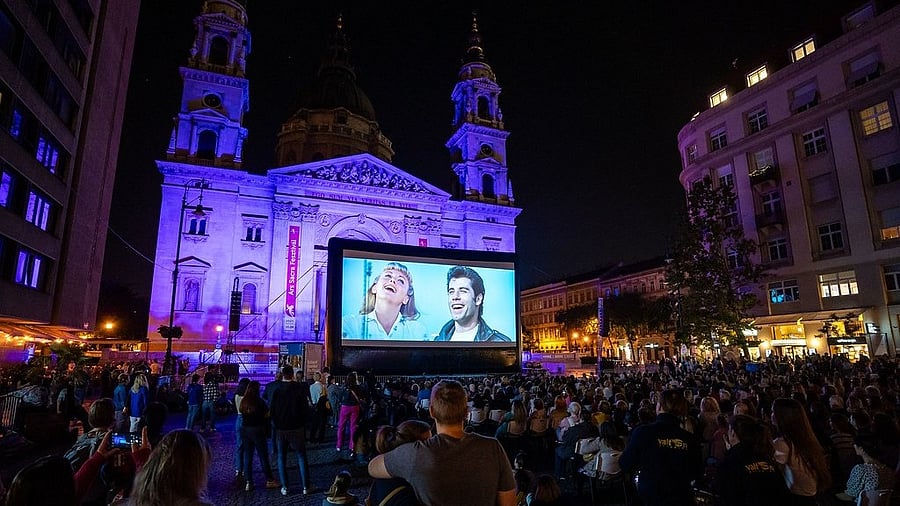
The Classics Film Marathon was held at St Stephen’s Square in Budapest.
Credit: BKFM / NFI Hungary
A strong sense of history — and the art of preserving the past as part of the living present — is the hallmark of modern civilization. Europe rose to the forefront of the modern world not only through military might, political strategy, economic ideas, or scientific progress, but also through its capacity to reimagine its past. By continuously reinventing its traditions, arts, and culture, the continent experienced a renaissance that remains central to its identity.
Whether in literature, music, fine arts, performing arts, or architecture, Europe’s engagement with its heritage is a constant intellectual act — a dialogue between memory and innovation. The inventions of printing, photography, and later, cinema, expanded this culture of preservation into a shared, collective experience. Today, every town and city across the continent stands as a living museum of evolving civilization — a mosaic of paintings, music, sculpture, and architecture. To this continuum, the seventh art — cinema — proudly belongs.
Budapest classics fest
Since 2017, the National Film Institute of Hungary has organised the Classics Film Marathon in Budapest, turning the city each autumn into a vibrant celebration of film heritage. For a whole week, Budapest becomes a city of cinema — alive with stories old and new, reframed in modern light and clarity. The Budapest Classics Film Marathon is more than a festival; it is a pilgrimage into film history, where restored masterpieces illuminate both the city and its people.
This unique event is both an experiment and a declaration of love — a commitment to cinema’s artistry and endurance. By upgrading technology and reviving classics for a new generation, it ensures that film history remains not just remembered but relieved. The eighth edition was held from September 16 to 21. It drew record audiences, filling historic theatres and transforming St Stephen’s Square (the venue) into an open-air cinema. Hundreds gathered beneath the stars for the joy of collective discovery.
Rediscovering classics
Over the years, the festival has grown into one of Europe’s most enchanting celebrations of cinema. Restored treasures from Hungary and across the world return to the big screen. This year, the festival paid tribute to Hungarian director Károly Makk, also marking the filmmaker’s centenary birth anniversary. Hungarian-born Hollywood screenwriter Joe Eszterhas was honoured at the festival, which also celebrated films directed by István Szabó, Atom Egoyan, and David Cronenberg, all produced by Robert Lantos.
Another milestone was the premiere of the restored 1943 melodrama Light and Shadow, the only film by Klára Tüdős Zsindelyné, one of Hungary’s pioneering women directors. Its rediscovery reflected the festival’s dedication to unearthing forgotten voices and giving them the stage they deserve.
Across 122 screenings, 26 student sessions, six roundtables, four ciné-concerts with live music, and numerous professional gatherings, the festival created an atmosphere of vibrant exchange. It was not just about watching films — it was about encountering their makers and inheritors.
Among the most memorable moments was Canadian filmmaker David Cronenberg’s intimate session at the University of Theatre and Film Arts. He opened up about his creative process and discussed his upcoming project Consumed. The conversation bridged generations — connecting legendary creators with emerging storytellers.
The festival also hosted the centenary General Assembly of the International Federation of Film Critics where critics from 29 countries gathered to reflect on the evolving landscape of global film criticism.
Film on Lumière Brothers
Yet perhaps the most relevant moment for the theme of the festival came with the presence of Thierry Frémaux, Artistic Director of the Cannes Film Festival and President of the Lumière Institute, who personally introduced Lumière! The Adventure Continues. Watching the Lumière Brothers’s 130-year-old images — the train pulling into a station, workers leaving a factory — projected before a rapt audience at the historic Urania National Film Theatre felt like witnessing the birth of cinema anew. The flickering frames glowed with vitality, reminding everyone why these images still hold such power — a perfect reflection of the festival’s mission to breathe new life into cinematic heritage.
(The author is a well known film critic and artistic director of Bengaluru International Film Festival)